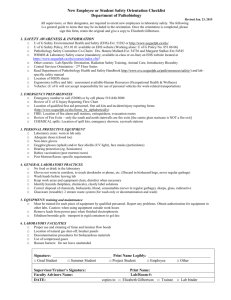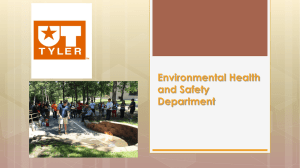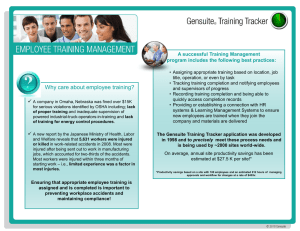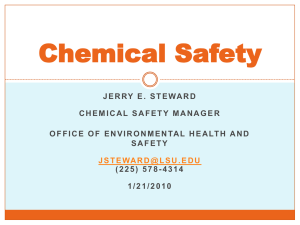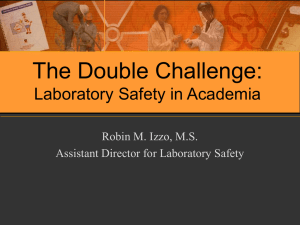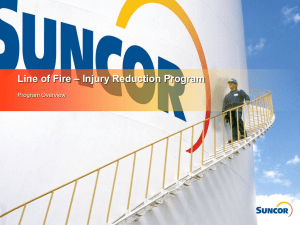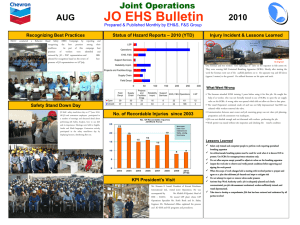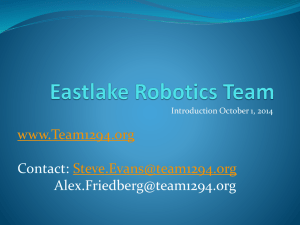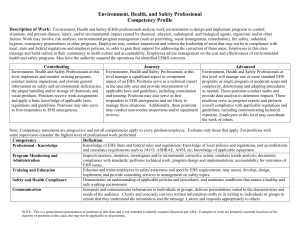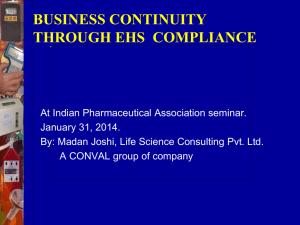Training - PharmaForum
advertisement
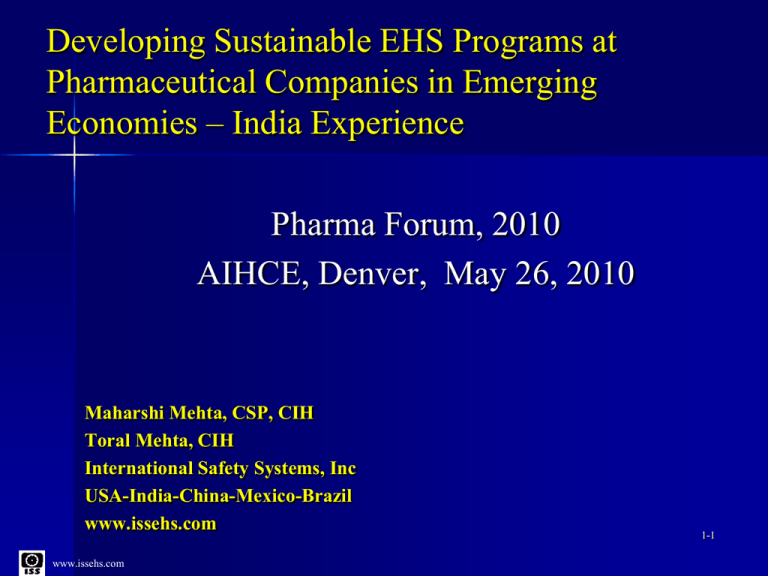
Developing Sustainable EHS Programs at Pharmaceutical Companies in Emerging Economies – India Experience Pharma Forum, 2010 AIHCE, Denver, May 26, 2010 Maharshi Mehta, CSP, CIH Toral Mehta, CIH International Safety Systems, Inc USA-India-China-Mexico-Brazil www.issehs.com www.issehs.com 1-1 Agenda Part 1: – – – – – Introduction and background Challenges in EHS Approaches Adopted Institutions Regulatory Framework Part 2: – – – – www.issehs.com Case Studies Supply Chain Site Pharma Corporation with manufacturing site Third Party Contract Manufacturers (TCM) 2 Basis for Presentation EHS capacity building in pharma companies in Emerging Economies Lessons learned from: – Conducting IH Process Safety Assessments at Pharma companies, supply chain and contract manufacturing sites – Conducting > 5000 API Surrogate monitoring – Assisting in exposure control and program implementation – Developing Pharma Company specific training modules and conducting training for companies and Third Party Manufacturers (TPM). – Most importantly, from Corporate EHS leaders and EHS work conducted globally 3 www.issehs.com Introduction India ranks third in terms of manufacturing pharma products by volume World’s largest producer of bulk drugs Worth $13B market ~ 10% annual growth Supply chain, third party manufacturing increasing rapidly Outsourcing expected to exceed $53B in 2010 Share of generic in US from Indian companies expected to grow at 6% in 2011 from 2% in 2006 http://www.slideshare.net/workosaur/indian-pharma-industry-presentation010709?from=share_email www.issehs.com 4 Clusters of Pharma Companies Baddi, Chandigarh Ahmedabad, Baroda, Ankleshwar Mumbai, Aurngabad Nasik www.issehs.com Hyderabad 5 Goa Infrastructure Pharma Manufacturing Over 450 colleges/departments offering degree and other education programs in pharmaceutical science More than 50,000 students graduates/year Manufacturing equipment, containment technologies R&D centers , laboratories www.issehs.com EHS Two colleges offering Master in Industrial Hygiene Program 150 Industrial Hygienists for all companies 5 CIHs Safety professionals or occupational physicians practicing IH No Accredited Lab for 6 API/Surrogate Challenges Limited Resources – IH professionals QA in exposure assessment data Financial constrains – Price Controls – Competition Manufacturing and outsourcing is increasing rapidly and corporate EHS and other resources are decreasing Trained corporate EHS professionals are unable to copup with demand for assistance Distance, time difference Limited sensitivity of site professionals to potent compounds www.issehs.com 7 Approaches: Corporate and Regional EHS Commendable efforts Audits Regional training programs and meetings Strong contract manufacturing programs Emphasis on selection of credible, competent and cost-effective EHS service providers Providing limited financial support 8 www.issehs.com Approaches Education Programs in Industrial Hygiene – University Level – Pharma specific training modules Managing cost effectively – Cost effective consulting – Exposure assessment strategy – three samples /HEG/API , never 1 sample – Analytical cost discounts – Return on investment (e.g., savings from loss of API) – Not loosing focus on QA www.issehs.com 9 Approaches Empowering region and manufacturing sites in EHS Training – At the foundation of sustainable EHS program – Site specific, anecdotal , workshop at the site – One corporation spends closed to $1B in all training Qualitative Risk assessment and Control Banding – If exposure is obvious, why do monitoring? – Exposure control and then monitoring Surrogate Monitoring 7/24 support 10 www.issehs.com Approaches – Supply Chain Corporate requirement for supplier to demonstrate exposure is below OEL through surrogate monitoring Corporate Audit Local services provider to do hand-holding for some time – – – – On site training on process safety and IH Limited exposure assessment Periodic supervision 7/24 support Limit number of suppliers based on EHS performance Shutting down operation when risk is imminent- provide limited assistance in reducing risk www.issehs.com 11 Case Study 1 Third Party Manufacturer (TPM) 12 www.issehs.com Case Study 1: Background Supplier of Bulk drug to Pharma Corporation Formaldehyde and other solvents used Open vessels, no inerting, high process safety risk Open formaldehyde handling Compressed air used for barrel transfer of chemicals EHS expertise not available at site Local workforce with limited knowledge on process safety and occupational hygiene 13 www.issehs.com Case Study 1: Approaches Adopted Corporate EHS professional conducted on site review Shut down the operation with high process safety and health risk TPM contacted us Detailed review and exposure assessment conducted, provided process and exposure controls – – – – Enclosed vessel Inerting specifications Grounding bonding, intrinsically safe lighting LEV, PAPRs Re-evaluation of TPM site and facility started within 3 months with significantly 14 reduced risk Case Study 1: Training In consultation with Corporate EHS staff conducted training for all suppliers and TPMs Risk specific manual developed Conducted 3-day workshop on basics of process safety, personal safety and industrial hygiene for all CMs and suppliers About 40 professionals from all TPM sites attended Ongoing support to TPMs 15 www.issehs.com Case Study 2 Corporation with Manufacturing in India 16 www.issehs.com Case Study 2: Background High potent compound formulations Effective containment for the most part Limited Training Previous exposure monitoring not conducted Half face APR or mask used 17 www.issehs.com Case Study 2: Approaches Adopted Detailed Qualitative Exposure Assessment Base line – limited Quantitative exposure assessment Exposures identified 7/24 support Participation in monthly meeting Recommendations: – Improve containment efficiencies – Work with equipment supplier – Additional exposure controls, e.g., LEV for compression machine part cleaning – PAPRs in place of APRs – Employee work practices 18 Case Study 2: Approaches Exposure Assessment – CIH and IH conducted periodical exposure assessments to identify continual improvements – More than 400 API samples collected over a period of 4 years to identify continual improvements – American Industrial Hygiene Association (AIHA) accredited laboratory in the USA analyzed samples – The facility demonstrated continual improvements Training – – – – www.issehs.com Developed training manual with seven chapters Specific for APIs used and risk identified Corporate EHS reviewed manual and provided input Conducted on site training with workshops 19 Case Study 3 Domestic Pharmaceutical Company 20 www.issehs.com Case Study 3: Background Supplier is one of the largest drug manufacturers Pharma Corporation selected the supplier Also, required the supplier to conduct surrogate monitoring and demonstrate that exposure will be controlled when their drugs are made Objectives – Containment validation – Identify cross contamination – FDA risk assessment 21 www.issehs.com Case Study 3: Approaches Adopted Surrogate monitoring – – – – – ISPE protocol followed Site specific protocol developed Lactose used More than 350 air and swab samples collected Containment validation and cross contamination studies performed simultaneously Recommendations: – Improved containment – Engineering controls (LEV) 22 www.issehs.com Organizations and Institutions Organizations of Pharmaceutical Producers of India (OPPI) – http://www.indiaoppi.com/ – Key collaborator in EHS – We have offered two Workshops on Industrial Hygiene and Safety Indian Pharmaceutical Manufacturers Association National Institute of Pharmaceutical Education and Research in India (4 locations) National Pharmaceutical Pricing Authority fixing and controlling prices of drugs 23 www.issehs.com Health and Safety Regulations Director General Factory Advise and Service Labor Institute (equivalent of NIOSH, HSE) – http://dgfasli.nic.in/welcome.html Indian Factories Act 1948 and subsequent amendments – http://dgfasli.nic.in/statutes5.htm – Schedule 2 on Permissible exposure limits State Rules Drugs and Pharmaceutical Industries covered under List of Industries Involving Hazardous Processes 24 www.issehs.com Conclusions Empower through effective training at regional and site levels Adopt cost effective approaches Focus on qualitative exposure assessment Focus on exposure controls Have strong control at design stage and surrogate monitoring program Containment validation pre-requisite for TPMs Remain connected directly or through service provider 25 www.issehs.com
